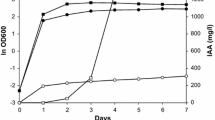Abstract
Obligately and facultatively methylotrophic bacteria with different pathways of C1 metabolism were found to be able to produce auxins, particularly indole-3-acetic acid (IAA), in amounts of 3–100 μg/ml. Indole-3-pyruvic acid and indole-3-acetamide were detected only in methylobacteria with the serine pathway of C1 metabolism (Methylobacterium mesophilicumand Aminobacter aminovorans).The production of auxins by methylobacteria was stimulated by the addition of L-tryptophan to the growth medium and was inhibited by ammonium ions. The methylobacteria under study lacked tryptophan decarboxylase and tryptophan side-chain oxidase. At the same time, they were found to contain several aminotransferases. IAA is presumably synthesized by methylobacteria through indole-3-pyruvic acid.
Similar content being viewed by others
References
Fall, R., Cycling of Methanol between Plants, Methylotrophs, and the Atmosphere, Microbial Growth on C1 Compounds, Lindstrom, M.E. and Tabita, F.R., Eds., Dordrecht: Kluwer Academic, 1996, pp. 343–350.
Long, R., Morris, R., and Polacco, J., Cytokinin Production by Plant-associated Methylotrophic Bacteria, Plant Physiol., 1997, Abstr. no. 1168.
Shepelyakovskaya, A.O., Doronina, N.V., Laman, A.G., Brovko, F.A., and Trotsenko, Yu.A., New Evidence for the Ability of Aerobic Methylotrophic Bacteria to Synthesize Cytokinins, Dokl. Akad. Nauk, 1999, vol. 368, no. 4, pp. 555–557.
Ivanova, E.G., Doronina, N.V., Shepelyakovskaya, A.O., Laman, A.G., Brovko, F.A., and Trotsenko, Yu.A., Facultative and Obligate Aerobic Methylobacteria Synthesize Cytokinins, Mikrobiologiya, 2000, vol. 69, no. 6, pp. 764–769.
Gordon, S.A. and Weber, R.P., Colorimetric Estimation of Indole-Acetic Acid, Plant Physiol., 1951, vol. 26, pp. 192–195.
Kirchner, J., Thin-Layer Chromatography, New York: Wiley, 1978, vol. 1, p. 242.
Yokota, T., Murofushi, N., and Takahashi, N., Extraction, Purification, and Identification, Hormonal Regulation of Development, MacMillan, J., Ed., Berlin: Springer, 1980, vol. 1, pp. 113–202.
Oberhansli, T., Defago, G., and Haas, D., Indole-3-Acetic Acid (IAA) Synthesis in the Biocontrol Strain CHAO of Pseudomonas fluorescens: Role of Tryptophan Side Chain Oxidase, J. Gen. Microbiol., 1991, vol. 137, pp. 2273–2279.
Manual of Methods for General Bacteriology, Gerhardt, P. et al., Eds., Washington: Am. Soc. Microbiol., 1981. Translated under the title Metody obshchei bakteriologii, Moscow: Mir, 1984, vol. 3.
Paris, C.G. and Magasanic, B., Tryptophan Metabolism in Klebsiella aerogenes: Regulation of the Utilization of Aromatic Amino Acids as Sources of Nitrogen, J. Bacteriol., 1981, vol. 145, no. 1, pp. 257–265.
Schneider, E.A. and Wightman, F., Metabolism of Auxin in Higher Plants, Annu. Rev. Plant Physiol., 1974, vol. 25, pp. 487–513.
Sharma, P.K. and Chakhal, V.P.S., Effect of Amino Group Acceptors on the Synthesis of Indole-3-Acetic Acid from Tryptophan by an Azotobacter, Mikrobiologiya, 1986, vol. 55, no. 6, pp. 1041–1043.
Mordukhova, E.A., Skvortsova, N.P., Kochetkov, V.V., Dubeikovskii, A.N., and Boronin, A.M., Synthesis of the Phytohormone Indole-3-Acetic Acid by Rhizosphere Bacteria of the Genus Pseudomonas, Mikrobiologiya, 1991, vol. 60, no. 3, pp. 494–499.
Crozier, A., Arruda, P., Jasmin, J.M., Monteiro, A.M., and Sandberg, G., Analysis of Indole-3-Acetic Acid and Related Indoles in Culture Medium from Azospirillum lipoferum and Azospirillum brasilense, Appl. Environ. Microbiol., 1988, vol. 54, no. 11, pp. 2833–2837.
Ruckadaschel, E., Kittell, B.L., Helinski, D.R., and Klingmuller, W., Aromatic Amino Acid Aminotransferases of Azospirillum lipoferum and Their Possible Involvement in IAA Biosynthesis, Azospirillum IV: Genetics, Physiology, Ecology, Klingmüller, W., Ed., Berlin, 1988, pp. 49–53.
Fett, W.F., Osman, S.F., and Dunn, M.F., Auxin Production by Plant-Pathogenic Pseudomonas and Xanthomonas, Appl. Environ. Microbiol., 1987, vol. 53, pp. 1839–1845.
Libbert, E., Wichner, S., Schiewer, U., Risch, H., and Kaiser, W., The Influence of Epiphytic Bacteria on Auxin Metabolism, Planta, 1966, vol. 68, pp. 327–334.
Austin, B. and Goodfellow, M., Pseudomonas mesophilica, a New Species of Pink Bacteria Isolated from Leaf Surfaces, Int. J. Syst. Bacteriol., 1979, vol. 29, no. 1, pp. 373–378.
Doronina, N.V., Kudinova, L.V., and Trotsenko, Yu.A., Methylovorus mays, a Novel Species of Plant-associated Aerobic Obligate Methylobacteria, Mikrobiologiya, vol. 69, no. 5, pp. 599–603.
Urakami, T., Araki, H., Oyanagi, H., Suzuki, K., and Komagata, K., Transfer of Pseudomonas aminovorans (den Dooren de Jong 1926) to Aminobacter gen. nov. as Aminobacter aminovorans comb. nov. and Description of Aminobacter aganoensis sp. nov. and Aminobacter niigataensis sp. nov., Int. J. Syst. Bacteriol., 1992, vol. 42, no. 1, pp. 84–92.
Doronina, N.V. and Trotsenko, Yu.A., Novel Plant-associated Thermotolerant Alkaliphilic Methylotroph of the Genus Paracoccus, Mikrobiologiya, vol. 69, no. 5, pp. 593–598.
Author information
Authors and Affiliations
Rights and permissions
About this article
Cite this article
Ivanova, E.G., Doronina, N.V. & Trotsenko, Y.A. Aerobic Methylobacteria Are Capable of Synthesizing Auxins. Microbiology 70, 392–397 (2001). https://doi.org/10.1023/A:1010469708107
Issue Date:
DOI: https://doi.org/10.1023/A:1010469708107




